Bayonets of the SKS self-loading carbine
The self-loading and automatic rifles of the last pre-war years were equipped with bayonets with knife-type blades, since the needle blades were considered obsolete and did not fully meet the requirements of the time. However, a decade later, this design of the bayonet received a new chance. The project of the Simonov self-loading carbine in its original configuration implied the use of a needle tetrahedral bayonet. The exact reasons for this decision are unknown, but it can be assumed that the use of such a blade was associated with the alleged features of its combat use and the placement of units in the marching or combat position.
To simplify the operation of weapons, the authors of the project proposed to make the bayonet integral. In this case, there is no need for a separate sheath and a relatively long process of installing the bayonet on the weapon. In this case, the question arose of optimizing the dimensions of the weapon: the constant presence of the blade in the combat position did not provide ease of use of the weapon, and could also pose some danger to the shooter and others. For this reason, there was a proposal to develop an original system of folding the bayonet to be placed in the desired position.
The bayonet attachment system was developed during the main project and remained almost unchanged in the future. Modifications, in accordance with the wishes of the customer, only the blade was subjected. At the same time, the general design of its fastenings did not change, which made it possible to simplify the transition to a new modification.
The shooter, armed with a SKS carbine of the first version, in hand-to-hand combat had to hit the enemy, inflicting thrusting blows with a needle tetrahedral bayonet. The blade of this cold weapon was a metal part with a sharpened fighting end and four edges, between which shallow valleys were provided. In the base area, the shape of the part was changed to a cylindrical one, at the end of which a through hole was provided for mounting the blade on the weapon axis.
When assembling the cylindrical base of the bayonet, it was necessary to put on a special tube with a sleeve intended for fastening the blade in a combat position. Inside the tube, there were fastenings for the spring, which kept it from spontaneous displacement, and there was an outside knurling for greater convenience of work. In front of the tube was attached a small stand with a ring with a diameter of 14 mm for mounting on the barrel. In the back of the tube was provided annular thickening with figured notches in the side parts. These cuts the tube should have been in contact with the carbine mounts.
According to various sources, the total length of the needle bayonet for the SKS carbine was 350-380 mm with a blade length of 250-300 mm. With such dimensions, the blade could be used in fencing on carbines, however, it allowed to do only piercing strikes, which to a certain extent reduced the range of techniques used.
To install the bayonet, the Simonov carbine received a special U-shaped stand, mounted under the barrel. The lower parts of this rack had a complex shape with a pair of teeth on different sides, with the help of which it was proposed to fix the bayonet in the desired position. In addition, an axis was provided for installing the bayonet. Established the possibility of dismantling the bayonet was not provided. In the stowed position, it was proposed to turn it on an axis and lay it under the barrel and the lodge, while part of the blade was located in a special recess in the lower part of the lodge. In the combat position, the blade was to be directed forward and protrude from under the muzzle of the barrel.
The original design of the mount allowed to change the position of the blade in minimal time. To transfer the bayonet from the marching position to the combat position, it was necessary to pull the tube with the ring back (towards the blade), after which the cuts of the annular thickening would not engage with the rack teeth. In this case, it was possible to turn the bayonet on the axis and fix the notches on the front tooth. At the same time, the ring of the tube was put on the muzzle of the barrel.
The lower part of the trunk struts had a characteristic curved shape, which ensured the "semi-automatic" work of the mountings. She allowed to fix the freed bayonet in the right position, without touching the tube. When you turn the bayonet to the desired position, the spring-loaded tube itself moved and then jumped on the tooth. In the course of the transfer to the firing position, the displacement of the tube also led to an independent putting on the ring on the barrel.
The use of a spring-loaded tube not only ensured a reliable retention of the bayonet in a combat or field position, but also improved the firing characteristics. The spring served as a shock absorber, thanks to which the accuracy and accuracy of the carbine did not change depending on the position of the bayonet.
Needle tetrahedral bayonets were installed on the SKS carbines of the first few batches. These weapons were supplied to various units of the Soviet armed forces and were actively used for some time. Around the beginning of the fifties, the project was finalized, resulting in the emergence of a new bayonet. The needle design ceased to suit the military, because of which a bayonet with a knife-like blade appeared. All subsequent self-loading carbines of the SG system. Simonov was equipped with just such melee weapons for hand-to-hand combat. As for the carbines with needle bayonets, they were used before the development of the resource and were written off according to the standard procedure. The forced replacement for the updated weapon, as far as is known, was not carried out.
The available means of fastening the bayonet on the arms had a fairly successful design, which made it possible to dispense with their rework. The new bayonet retained all the elements of the existing system, from the U-shaped stand with a figured lower part on the barrel to a movable tube with a ring. However, the blade itself was redesigned. When creating a new blade, the experience of creating and using bayonet knives for weapons of previous models was taken into account, which affected its design.
The main part of the bayonet of the second model was the oblong blade of the knife-shaped form. The combat end of the bayonet had a double sharpening that lasted only along one edge. According to some information, part of the bayonets had only a sharpened combat end, and the rest of the blade could not be used for cutting. To increase the rigidity on both surfaces of the blade provided downwards. The blade had a narrowed heel, which passes into the base, which was located under the movable tube. As before, there was a hole under the axis at the rear end.
The total length of the knife-type bayonet was 307 mm, the blade length - 222 mm. The maximum width of the blade was 22 mm. Such a width of the bayonet provided acceptable fighting qualities, and also made it possible not to change the design of the mountings. In the combat position, the bayonet protruded before the muzzle, in the marching position it was located under the barrel and the ramrod. Most of the blade was under the barrel, and the combat end was located in a special slot in the bottom of the wooden box. The new bayonet had a shorter length in comparison with the old one, because of which the bed also did not undergo special modifications.
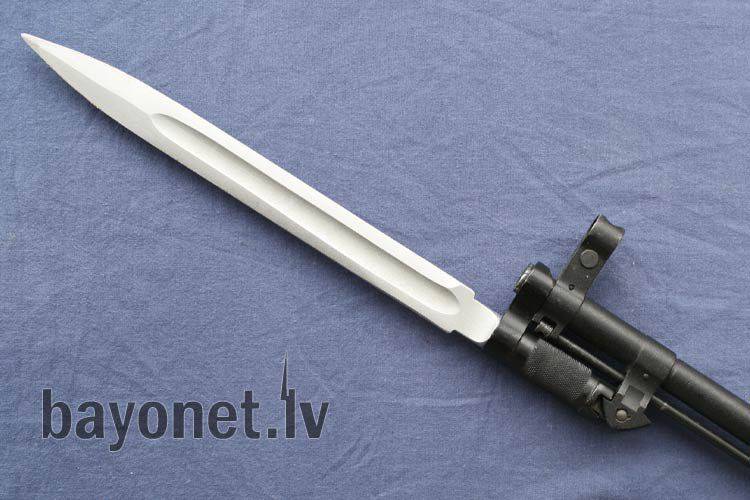
SCS bayonet in a combat position. Photo Bayonet.lv
Only SCS carbines of the first few series were equipped with needle bayonets. Later, their production ceased, and new weapons began to receive knife-type blades. “New” carbines eventually forced out weapons with needle bayonets and became the main representative of their class in the Soviet army. This resulted in some changes in the governing documents. Thus, in the first edition of the Manual on the Small Case for the ACS (1954), both versions of bayonets were described. At the next edition (1957) from the Manual, references to the needle blade were lost. From this time on, only knife-shaped blades were described in the documents.
Active exploitation of Simonov self-loading carbines with integral bayonets continued until the end of the fifties. After that, it was decided to transfer all the main divisions of the ground forces to automatic rifles and light machine guns. In this system, there was no place for self-loading carbines, which is why they began to be sent to the reserve. However, the operation of the SCS and, as a result, the bayonets was not over. Over the next few decades, these weapons remained in service with subunits whose task is not a direct confrontation with the enemy. In addition, the SCS is still the main weapon of the Presidential Regiment, and is also used by various security structures.
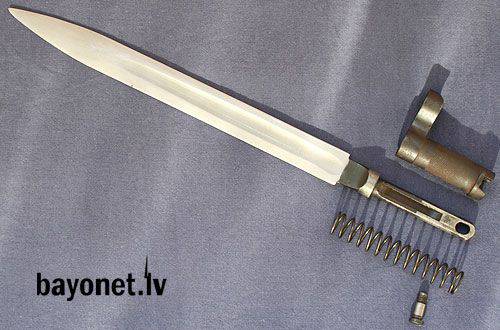
Knife-shaped bayonet of the Chinese carbine "Type 56". Photo Bayonet.lv
Like many other models of Soviet-made small arms, the SKS carbine was produced not only in the USSR, but also abroad. In the context of bayonets, the production of these weapons in China is of the greatest interest. Documentation and license were transferred to China in the mid-fifties. The Chinese copy of the SCS received the designation “Type 56” and was produced for a long time, entering into service with various units of the People’s Liberation Army of China.
The most interesting feature of Chinese production was the approach to the use of bayonets. Early 56 Type carbines were completed with knife-like blades, similar to the second version of the bayonet for the Soviet SKS. Initially, the bayonets did not differ from the Soviet ones and had the same dimensions. In the future, Chinese industry has mastered the production of shortened carbines "Type 56" for the civilian market. Such weapons received a bayonet with a total length of 260 mm with a 170-mm blade. The blade length was reduced due to its middle part, and the shape and size of the combat end and heels remained the same.
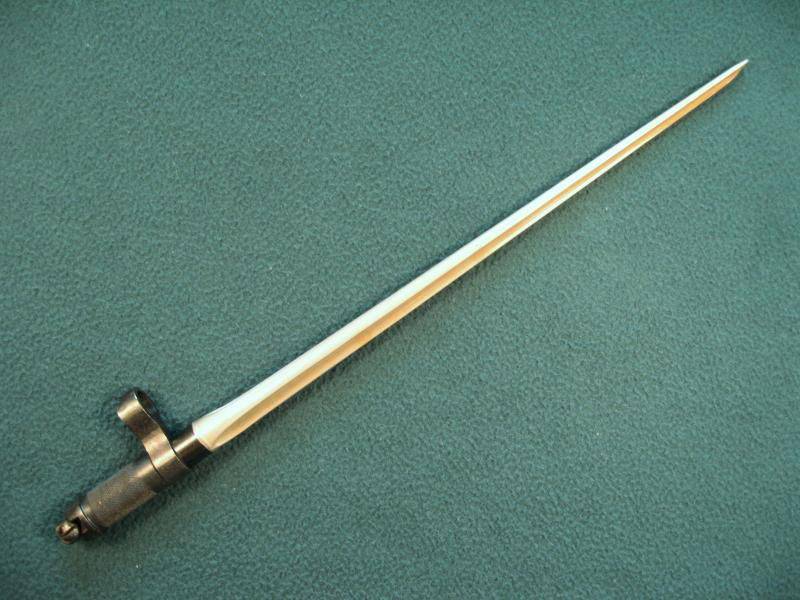
Needle bayonet made in China. Photo Nakop.ru
Knife-type bayonets were made in China until the mid-sixties. After that, it was decided to switch to needle bayonets. All subsequent carbines "Type 56" were completed with cold weapons, which were previously abandoned in the Soviet Union. The Chinese needle bayonets differed from the Soviet size and shape. So, instead of four faces, they had three, and the base of the bayonet had other contours. Over time, the production of such bayonets for civilian carbines began. Such a modification had a length of 270 mm and a blade length of 180 mm.
For several decades, the Soviet and foreign industry produced about 15 million of self-loading SG carbines. Simonov and their modifications. The vast majority of these weapons received various types of bayonets. At the same time, for obvious reasons, most of the SKS carbines were completed with knife-type blades. Through the efforts of the Chinese industry, the share of needle bayonets was noticeably increased over time, but the primacy remained behind the knife-shaped blades.
The impossibility of dismantling the bayonet from the carbine led to the fact that such edged weapons were in service with the SCS until the end of their operation. Currently, such weapons are still in service with some domestic security structures, as well as various foreign countries. Also continues to release civilian versions of the carbine, but they are not equipped with blades.
Based on:
http://bayonet.lv/
http://world.guns.ru/
http://huntsmanblog.ru/
http://miliru.com/
http://forum.guns.ru/
Manual on the shooting case. 7,62-mm Simonov self-loading carbine (SCS). - M .: Military publishing house of the Ministry of Defense of the USSR, 1954
Manual on the shooting case. 7,62-mm Simonov self-loading carbine (SCS). Second edition, revised and supplemented - M .: Military Publishing House of the USSR Ministry of Defense, 1957
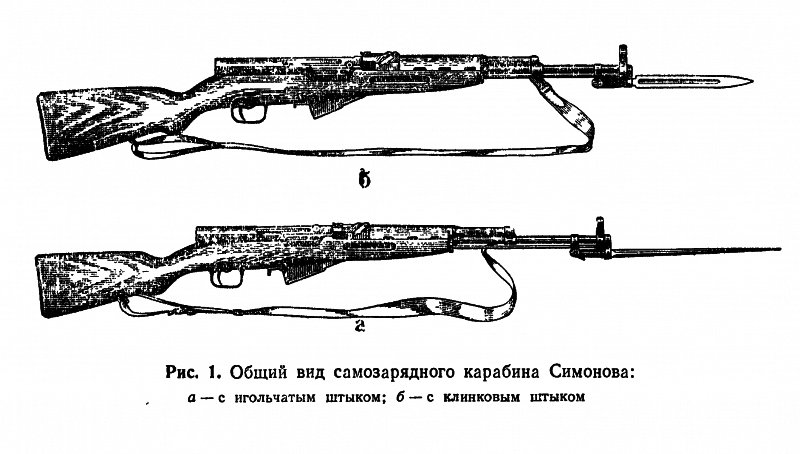
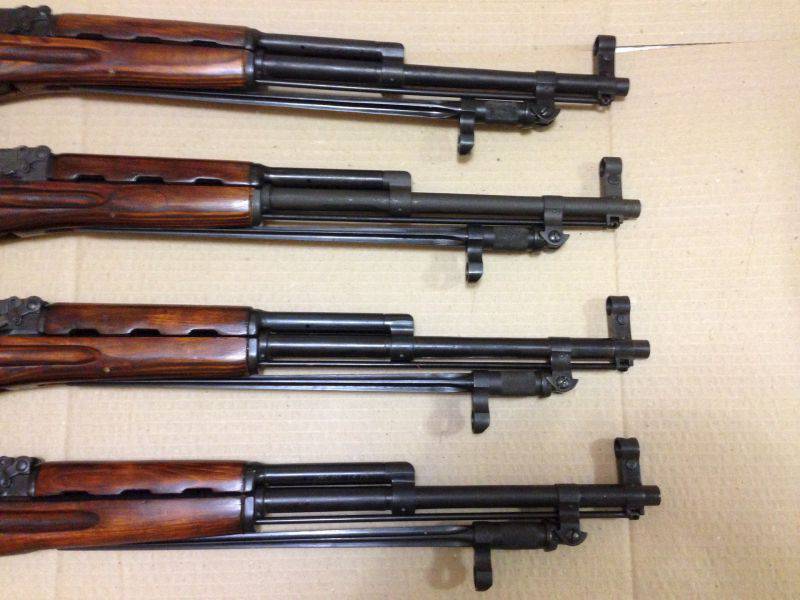
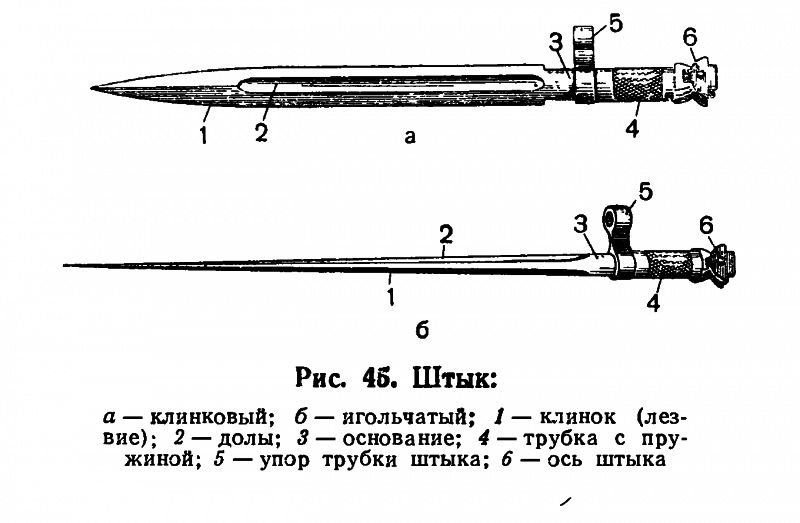
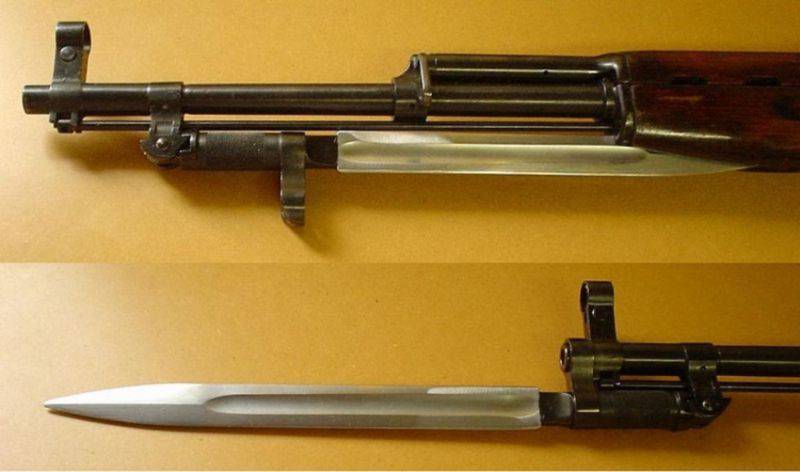
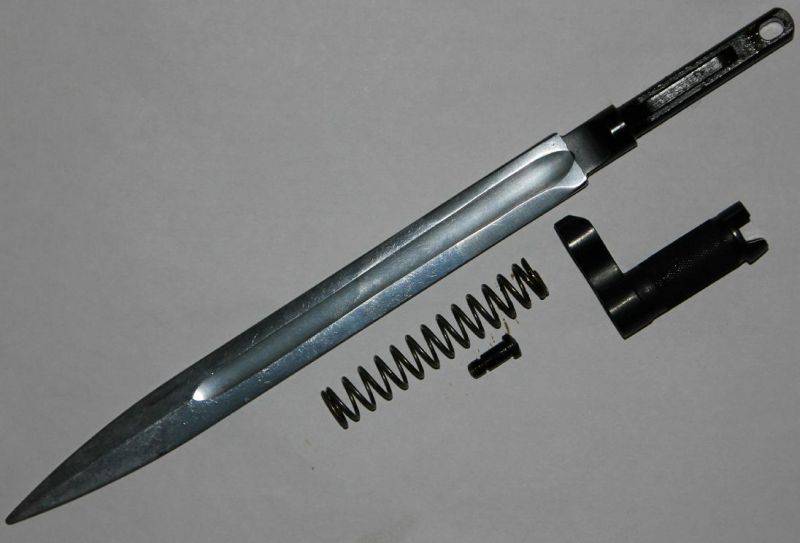
Information